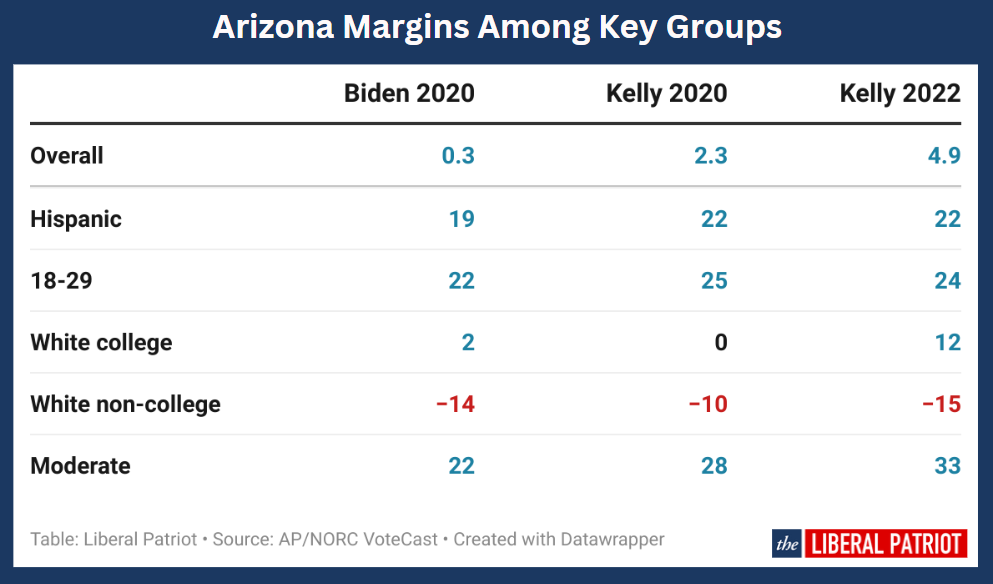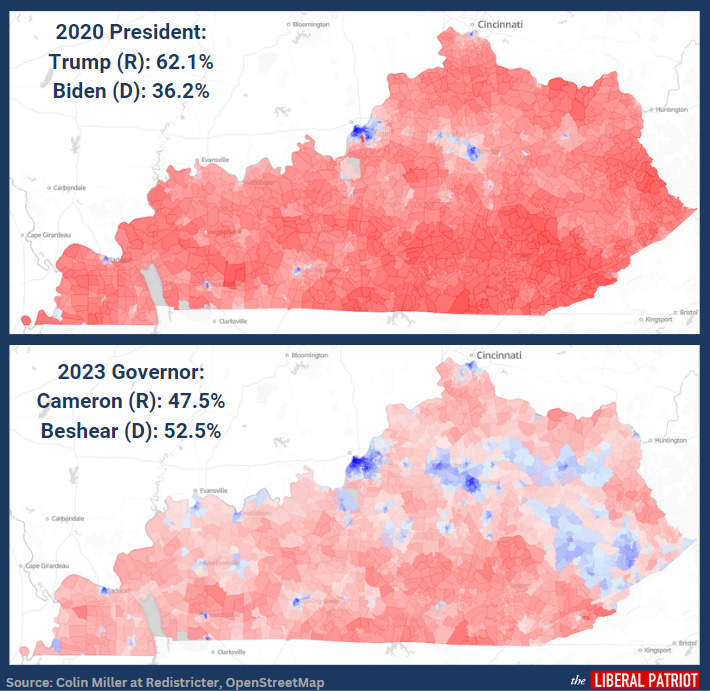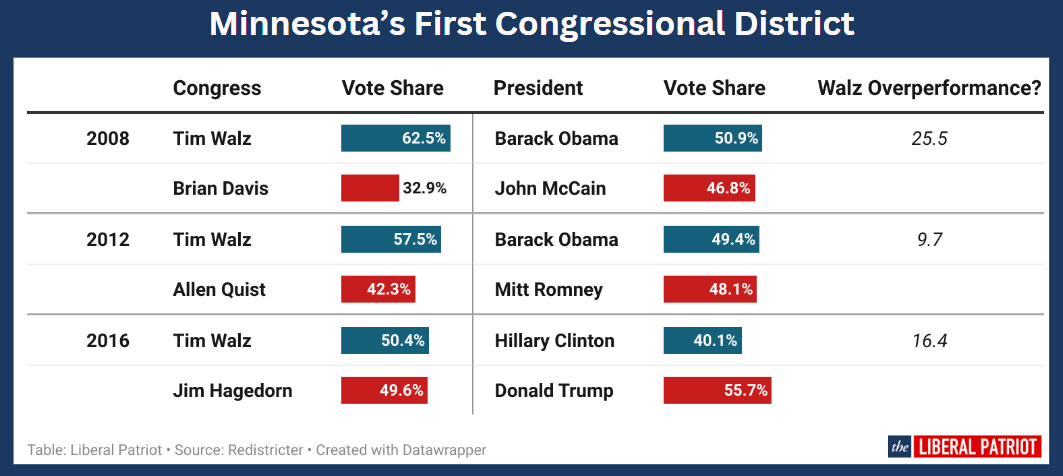With her virtual nomination nearing, Kamala Harris’s vice presidential search is in full swing. The Democratic ticket is expected to embark on a swing-state tour next week—meaning her selection is just days away. There is always a chance a dark-horse candidate emerges late in the game, but current campaign chatter suggests she is focusing on four men: Arizona’s Mark Kelly, Kentucky’s Andy Beshear, Minnesota’s Tim Walz, and Pennsylvania’s Josh Shapiro.
Each has won multiple elections in states ranging from purple-ish to ruby red, but who has the best record of overperformance? To the data we go.
Senator Mark Kelly (Arizona)
Kelly was first elected to the Senate in 2020, defeating Republican Martha McSally (who had also lost to Krysten Sinema two years prior). Sharing the ballot with Biden, Kelly won by 2.3 points, outperforming Biden’s razor-thin 0.3 point margin. Though just a couple points, his overperformance is nothing to scoff at, particularly in a state that is redder down-ballot. Kelly did four points better than Biden with non-college whites and, perhaps most importantly, six points better with moderate voters.
Two years later, Kelly ran for a full term against Blake Masters, who was—to use the word of the week—a very weird candidate. In a GOP-leaning year, Kelly romped to a five-point win, racking up a 12-point margin with white college voters and a 33-point margin with moderates. Split Ticket’s “wins above replacement” model ranked Kelly as the second-highest scoring battleground Senator.
Governor Andy Beshear (Kentucky)
The son of the former governor, Andy Beshear has turned in a pair of massive overperformances to win two terms as governor of Kentucky, a state Biden lost by 26 points. In 2019, Beshear defeated controversial incumbent Matt Bevin by 0.4 points before winning reelection against Daniel Cameron in 2023 by a more comfortable 5-point margin.
Kentucky’s off-year gubernatorial elections undoubtedly helped Beshear as he was able to run localized campaigns and dodge the drag of unpopular national Democrats. Had he run in 2020 or 2022, he likely would have lost. But even in an off-year, a 30-point overperformance is quite impressive.
Not only did Beshear run up the margins in the more affluent suburbs of Louisville and Lexington, but he made significant inroads in historically Democratic eastern Kentucky. Very few Democrats today could replicate the white, working-class margins that Beshear achieved in coal country last year.
Governor Tim Walz (Minnesota)
Minnesota’s governor has suddenly emerged as the preferred VP candidate for many on the left. A six-term representative for a swath of southern Minnesota, Walz holds a strong electoral track record. In three consecutive presidential races he significantly outran the top of the Democratic ticket, even as his constituency trended rightward. His 2016 contest is the most impressive example: Walz survived a challenge from Jim Hagedorn despite Trump trouncing Clinton in the district by more than 15 points.
In 2018, Walz rode the blue wave to the governor’s mansion, defeating his GOP opponent by 11 points—a margin in line with other statewide Democratic totals. Four years later, in the most recent midterms, Walz was once again an overperformer. In 2022, Minnesota Democrats won the cumulative House popular vote by two points. In the state legislature, they won the popular vote by three. Walz, meanwhile, won reelection by 8 points.
Governor Josh Shapiro (Pennsylvania)
In the eight years since his first statewide bid, Shapiro has turned in three excellent showings. Though a 2022 thrashing of Doug Mastriano earned the most attention, his 2020 Attorney General race is perhaps the most impressive performance—and a strong argument to be selected as vice president. Let’s compare his margins to Biden’s in heavily white, working-class Northeastern Pennsylvania.
“Scranton Joe” actually lost the region by double digits, while Shapiro came up less than half a point short. His ten-point overperformance in this historically Democratic region is indicative of real strength with the very type of voters who have abandoned the party.
Statewide, Shapiro won by 4 points compared to Biden’s one, proving that he can appeal to Trump supporters—even when they share a ballot. His 15-point gubernatorial victory two years later is the cherry on top: Shapiro won Northeastern Pennsylvania, ran up astronomical margins in the Philadelphia collar counties, and won moderates by a whopping 50 points.
All four options have proven appeal with the independent voters Democrats need to hold the White House. And a popular, well-vetted vice president is undoubtedly important—just ask the Trump campaign. But a moderate white governor does not ensure a golden ticket.
No matter who she selects, Harris herself must make appeals to independents. Vice presidents tend to move the electoral needle only slightly, even in their home state. And the best way for Harris to actually win over moderate voters is—you guessed it—to moderate her own positions. With the nomination secured and a vice president in tow, we’ll see if Harris next looks to the center on policy.










I'm rooting for Shapiro. Kelly would be good, but it's probably more important to lock up Pennsylvania than reach for Arizona. And the fact that the far left hates Shapiro is a point in his favor.
I live in Minnesota - Tim Walz is not moderate in the least. When he served in Congress, he was moderate enough to get elected in a somewhat conservative House district; his folksy manner appealed to the majority of voters who vote mostly on personality. But when he became Governor, he went hard Left: 100% with the radical transgender agenda, abortion rights for all nine months, big tax increase to create new welfare programs, a slave to the state teachers union, etc. Before Biden dropped out, he declared that Biden was cognitively fit enough to serve another four year term - a blatant lie, and he knew it.